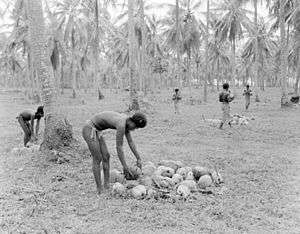Copra plantations in New Guinea

Copra Plantations in New Guinea have been cultivated since the late 19th century. Originally established by German colonialists, they were superseded by Australian interests following World War II.
Early colonialists
In 1884, German settlers arrived in eastern New Guinea (now Papua New Guinea), and planted Coconut palms (Cocos nucifera) for the production of copra, the dried flesh of the coconut. They established the colony of German New Guinea in the north eastern quarter of the island and numerous coconut plantations around coastal areas. They were afraid of venturing too far inland.[1] To counter the growing German presence in the region, the Australian state of Queensland established the Territory of Papua as a de facto possession covering approximately the south east third of the island.[1] Both the Queensland and German plantations thrived, providing opulent living conditions for the expatriates. Grand mansions were built on the plantations, complete with luxury furnishings.[1] Much of the labour was performed by New Guinea natives.[2] The towns of Port Moresby and Rabaul were founded as a result of the economic activity surrounding the plantations.[1]
In 1914, Australia sent a small military force to capture the towns of Kokopo and Rabaul. Two Germans were killed in the process, while the remaining German plantation owners were initially sent back to work on their plantations.[1] The 1919 Treaty of Versailles saw Germany lose all its overseas colonies, including German New Guinea.[2] It became the Territory of New Guinea, a League of Nations Mandate Territory under Australian administration.
Recent history
In 1985 the Copra Marketing Board,[3] an initiative by the PNG government took over copra production. In 1993 Kokonas Industri Koporasen (KIK) built a copra mill in Manang and effectively gained monopoly control over the marketing. The ill-fated operations of the Copra Marketing Board virtually decimated copra production with copra exports from PNG falling to negligible levels up until 2004. In 2003 the government ended KIK’s monopoly powers over marketing, and a year later KIK suffered losses that forced the group to call in a liquidator.
In a joint announcement in April 2004 the liquidator of PNG Coconut Commodities, Rex Paki, Coconut Oil Production Madang Ltd (COPM, owned by Donald Brownlie Fleming) and the original mill owners, KIK, announced that COPM had taken possession of the mill.
The copra mill in Madang changed hands in a K7.8 million (US$2.4 million) deal [4] by the Australian-owned Coconut Oil Production Madang Ltd (COPM). This gave long-suffering copra growers their best news in many years.
COPM immediately raised the price of first grade copra by K100 to K725 (US$223) a ton.
The country’s only other coconut mill being owned by the Carpenter Group located in Rabaul.
This was an excellent outcome for everybody involved in the copra industry in PNG, in particular for the local growers and local people who relied upon income from copra.
According to the Central Bank the PNG’s copra exports in 2003 had plunged to 3,600 tons in that year, levels at which copra exports could be said to be close to extinction, in contrast to exports of more than 9,100 tons by the end of 2004.
References
- 1 2 3 4 5 "Howard’s history with PNG". Papua New Guinea Post-Courier. 2004-07-30. Retrieved 2007-12-20.
- 1 2 Marr, David (2006-06-10). "Howard's hidden past". The Age. Retrieved 2007-12-20.
- ↑ PNG Gov't. Copra Marketing Board. http://www.paclii.org/pg/legis/consol_act/cmba1983193/
- ↑ PNGnius. PNG COPRA MILL CHANGES HANDS IN $2.4 MILLION DEAL. http://nomoa.com/articles/PNGnius/2004-04-07%2003:34